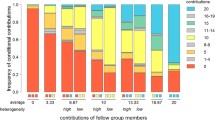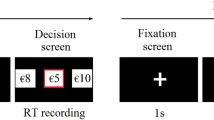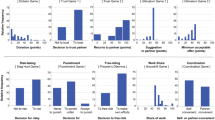Abstract
An experiment was conducted to test the hypothesis that cooperation in a social dilemma context could be facilitated by inducing participants to emit “social psychophysical” cues, information in the perceptual array that affords meaningful and consequential social inferences. In particular, participants were asked to engage in mutual eye gaze, to touch one another gently, to communicate in a virtual chat room, or to tap out rhythms in synchrony. All but the last of these manipulations increased contributions to a public good in all-male but not all-female groups. These results suggest the inference systems that are engaged when individuals make decisions about whether or not to cooperate in a group context are responsive to relatively low level nonverbal behavioral cues.
Similar content being viewed by others
References
Baron-Cohen, S. (1995). Mindblindness: An essay on autism and theory of mind. Cambridge, MA: MIT Press.
Bem, D. J. (1967). Self-perception: An alternative interpretation of cognitive dissonance phenomena. Psychological Review, 74, 183–200.
Bohm, J. K., & Hendricks, B. (1997). Effects of interpersonal touch, degree of justification, and sex of subject on compliance with a request. Journal of Social Psychology, 137, 460–469.
Bornstein, G., & Rapoport, A. (1988). Intergroup competition for the provision of step-level public goods: Effects of preplay communication. European Journal of Social Psychology, 18, 125–142.
Bouas, K. S., & Komorita, S. S. (1996). Group discussion and cooperation in social dilemmas. Personality and Social Psychology Bulletin, 22, 1144–1150.
Brewer, M. B., & Brown, R. J. (1998). Intergroup relations. In D. T. Gilbert, S. T. Fiske, & G. Lindzey (Eds.), The handbook of social psychology (4th ed., pp. 554–594). Boston: McGraw-Hill.
Brewer, M. B., & Kramer, R. M. (1986). Choice behavior in social dilemmas: Effect of social identity, group size, and decision framing. Journal of Personality and Social Psychology, 50, 543–549.
Caporael, L. R., & Brewer, M. B. (1991). Reviving evolutionary psychology: Biology meets culture. Journal of Social Issues, 47, 187–195.
Chen, X. P. (1996). The group-based binding pledge as a solution to public goods problems. Organizational Behavior and Human Decision Processes, 66, 192–202.
Chen, X. P., & Komorita, S. S. (1994). The effects of communication and commitment in a public goods social dilemma. Organizational Behavior and Human Decision Processes, 60, 367–386.
Condon, W. S. (1980). The relation of interactional synchrony to cognitive and emotional processes. In M. R. Key (Ed.), The relationship of verbal and nonverbal communication (pp. 49–65). The Hague: Mouton Publishers.
Darwin, C. (1871). The descent of man and selection in relation to sex. London: Murray.
Davis, D. D., & Holt, C. A. (1993). Experimental economics. Princeton, NJ: Princeton University Press.
Dawes, R. M. (1980). Social dilemmas. Annual Review of Psychology, 31, 169–193.
Dawes, R. M., McTavish, J., & Shaklee, H. (1977). Behavior, communication, and assumptions about other people's behavior in a commons dilemma situation. Journal of Personality and Social Psychology, 35, 1–11.
Dawes, R. M., van de Kragt, A. J. C., & Orbell, R. M. (1988). Not me or thee but we: The importance of group identity in eliciting cooperation in dilemma situations: Experimental manipulations. Acta Psychologica, 68, 83–97.
Eckel, C. C., & Grossman, P. J. (in press). Differences in the economic decisions of men and women: Experimental evidence. In C. Plott and V. Smith. (Eds.)., Handbook of experimental economics results. New York: Elsevier.
Farah, M. J., Wilson, K. D., Drain, H. M., & Tanaka, J. R. (1995). The inverted face inversion effect in prosopagnosia: Evidence for mandatory, face-specific perceptual mechanisms. Vision Research, 35, 2089–2093.
Feshbach, S. (1994). Nationalism, patriotism, and aggression: A clarification of functional differences. In L. R. Huesmann (Ed.), Aggressive behavior: Current perspectives (pp. 275–291). New York: Plenum Press.
Fodor, J. (1983). The modularity of mind: An essay on faculty psychology. Cambridge, MA: Bradford.
Gaertner, L., & Insko, C. A. (2000). Intergroup discrimination in the minimal group paradigm: Categorization, reciprocation, or fear? Journal of Personality and Social Psychology, 79, 77–94.
Gigerenzer, G. (1997). The modularity of social intelligence. In A. Whiten & R. W. Byrne (Eds.), Machiavellian intelligence II: Extensions and evaluations (pp. 264–288). Cambridge, England: Cambridge University Press.
Goldman, M., Kiyohara, O., & Pfannensteil, D. A. (1985). Interpersonal touch, social labeling, and the foot-in-the-door effect. The Journal of Social Psychology, 125, 143–147.
Grammer, K., Kruck, K. B., & Magnusson, M. S. (1998). The courtship dance: Patterns of nonverbal synchronization in opposite-sex encounters. Journal of Nonverbal Behavior, 22, 3–29.
Hornik, J. (1987). The effect of touch and gaze upon compliance and interest of interviewees. Journal of Social Psychology, 127, 681–683.
Kempton, W. (1980). The rhythmic basis of interactional micro-synchrony. In M. R. Key (Ed.), The relationship of verbal and nonverbal communication (pp. 67–75). The Hague: Mouton Publishers.
Kerr, N. L., & Kaufman-Gilliland, C. M. (1994). Communication, commitment, and cooperation in social dilemmas. Journal of Personality and Social Psychology, 66, 513–529.
Kleinke, C. L. (1977). Compliance to requests made by gazing and touching experimenters in field settings. Journal of Experimental Social Psychology, 13, 218–223.
Kleinke, C. L. (1980). Interaction between gaze and legitimacy of request on compliance in a field setting. Journal of Nonverbal Behavior, 5, 3–12.
Kleinke, C. L. (1986). Gaze and eye contact: A research review. Psychological Bulletin, 100, 78–100.
Kurzban, R. (1998). The social psychophysics of cooperation in groups. Unpublished doctoral dissertation, University of California Santa Barbara, Santa Barbara, California.
Kurzban, R., & Leary, M. (2000). Evolutionary origins of stigmatization: The functions of social exclusion. Psychological Bulletin, 127, 187–208.
Kurzban, R., McCabe, K., Smith, V. L., & Wilson, B. J. (in press). Commitment and reciprocity in a real-time public goods game. Personality and Social Psychology Bulletin.
Ledyard, J. O. (1996). Public goods: A survey of experimental research. In J. Kagel & A. E. Roth (Eds.), Handbook of Experimental Economics (pp. 111–194). Princeton, NJ: Princeton University Press.
Lee, R., & DeVore, I. (Eds.). (1968). Man the hunter. Chicago: Aldine.
Luhtanen, R., & Crocker, J. (1992). A collective self-esteem scale: Self-evaluation of one's social identity. Personality and Social Psychology Bulletin, 18, 302–318.
Marwell, G., & Ames, R. (1979). Experiments in the provision of public goods, I: Resources, interest, group size and the free rider problem. American Journal of Sociology, 84, 1335–1360.
Millikan, R. B. (1984). Language, thought, and other biological categories. Cambridge MA: MIT Press.
Olson, M. (1965). The logic of collective action. Cambridge, MA: Harvard University Press.
Rapoport, A. (1988). Provision of step-level public goods: Effects of inequality in resources. Journal of Personality and Social Psychology, 54, 432–440.
Rapoport, A., & Bornstein, G. (1989). Solving public good problems in competition between equal and unequal size groups. Journal of Conflict Resolution, 33, 460–479.
Remland, M. S., Jones, T. S., & Brinkman, H. (1995). Interpersonal distance, body orientation, and touch: Effects of culture, gender, and age. Journal of Social Psychology, 135, 281–297.
Sidanius, J., & Pratto, F. (2001). Social dominance: An intergroup theory of social hierarchy and oppression. New York: Cambridge University Press.
Smith, D. E., Gier, J. A., & Willis, F. N. (1982). Interpersonal touch and compliance with a marketing request. Basic and Applied Social Psychology, 3, 35–38.
Strack, F., Martin, L. L., & Stepper, S. (1988). Inhibiting and facilitating conditions of the human smile: A nonobtrusive test of the facial feedback hypothesis. Journal of Personality and Social Psychology, 54, 768–777.
Tajfel, H., Billig, M. G., Bundy, R. P., & Flament, C. (1971). Social categorization and intergroup behaviour. European Journal of Social Psychology, 1, 149–178.
Tajfel, H., & Turner, J. C. (1986). An integrative theory of intergroup relations. In S. Worchel & W. G. Austin (Eds.), Psychology of intergroup relations (pp. 7–24). Chicago: Nelson-Hall.
Tiger, L. (1969). Men in groups. New York: Random House.
Tooby, J., & Cosmides, L. (1988). The evolution of war and its cognitive foundations (Tech Rep. No. 88–1). Palo Alto, CA: Institute for Evolutionary Studies.
Tooby, J., & Cosmides, L. (1996). Friendship and the banker's paradox: Other pathways to the evolution of adaptations for altruism. Proceedings of the British Academy, 88, 119–143.
Trivers, R. L. (1971). The evolution of reciprocal altruism. Quarterly Review of Biology, 46, 35–57.
Van Vugt, M., Van Lange, P. A. M., & Meertens, R. M. (1996). Commuting by car or public transportation? A social dilemma analysis of travel mode judgments. European Journal of Social Psychology, 26, 373–395.
Wichman, H. (1970). Effect of isolation and communication on cooperation in a two-person game. Journal of Personality and Social Psychology, 16, 114–130.
Williams, K. D., Jackson, J. M., & Karau, S. J. (1995). Collective hedonism: A social loafing analysis of social dilemmas. In D. A. Schroeder (Ed.), Social dilemmas: Perspectives on individuals and groups. (p. 115–141). Westport, CT: Praeger.
Willis, F. N., & Hamm, H. K. (1980). The use of interpersonal touch in securing compliance. Journal of Nonverbal Behavior, 5, 49–55.
Wilson, R. K., & Sell, J. (1997). "Liar, liar..." Cheap talk and reputation in repeated public goods settings. Journal of Conflict Resolution, 41, 695–717.
Wit, A. P., & Wilke, H. A. M. (1992). The effect of social categorization on cooperation in three types of social dilemmas. Journal of Economic Psychology, 13, 135–151.
Wrangham, R., & Peterson, D. (1997). Demonic males: Apes and the origins of human violence. Boston: Houghton Mifflin.
Author information
Authors and Affiliations
Corresponding author
Rights and permissions
About this article
Cite this article
Kurzban, R. The Social Psychophysics of Cooperation: Nonverbal Communication in a Public Goods Game. Journal of Nonverbal Behavior 25, 241–259 (2001). https://doi.org/10.1023/A:1012563421824
Issue Date:
DOI: https://doi.org/10.1023/A:1012563421824




